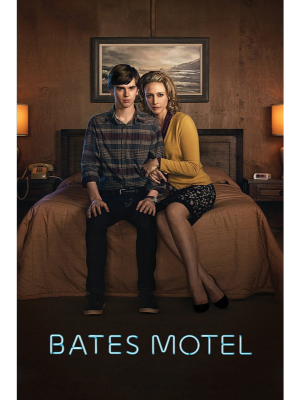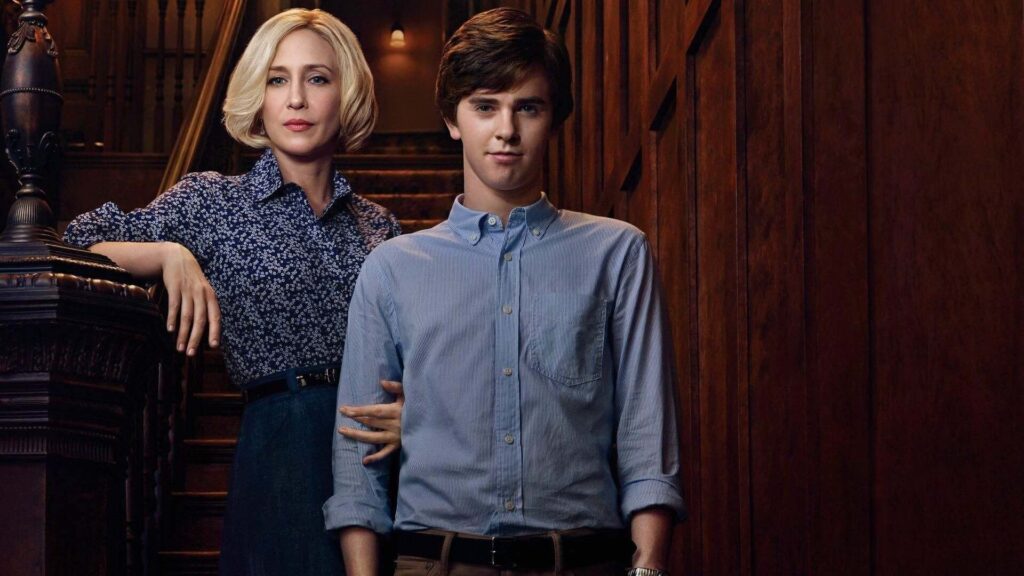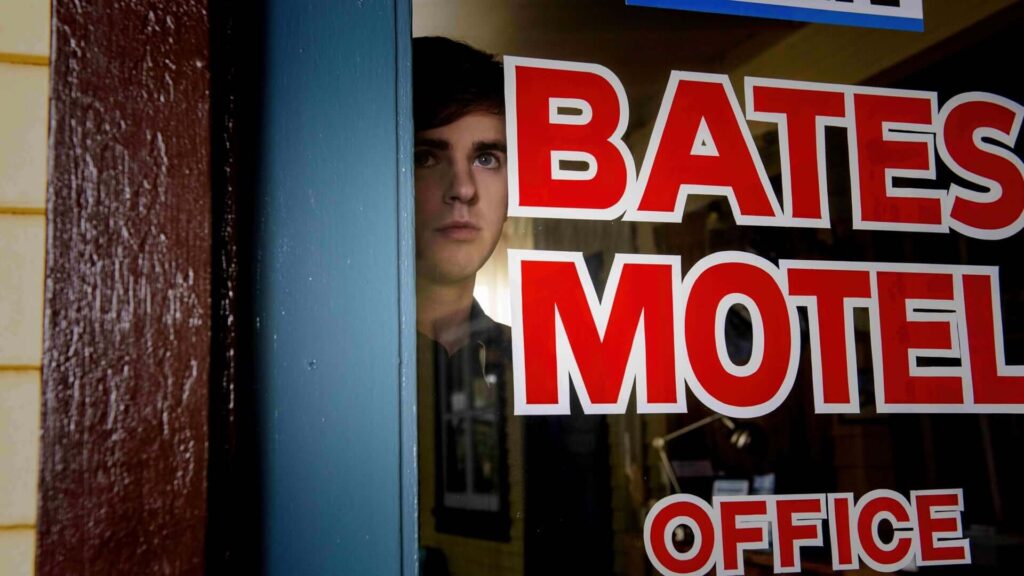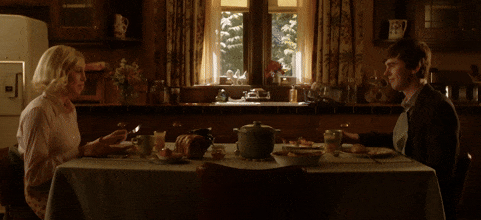Bates Motel

TV-MA, (2013 – 2017), Drama/Horror, 45m
Table of Contents
What Is Bates Motel About?
This modern Prequel to Psycho explores the mental deterioration of a teenager and his complex bond with his mother.
Why You Should Watch Bates Motel
Bates Motel is a brilliant reinvention of one of the most iconic horror stories in cinematic history. The series, serving as a contemporary prequel to Alfred Hitchcock’s “Psycho,” delves into the complex relationship between the young Norman Bates (Freddie Highmore) and his mother Norma (Vera Farmiga). It traces the tragic descent of Norman into mental instability and explores the grim secrets hidden within a seemingly tranquil town.
Freddie Highmore’s portrayal of Norman Bates is a study in understated brilliance. Highmore excels at presenting the duality of his character — the innocent, caring young man on one side, and the disturbing alter-ego on the other. He navigates the complexities of Norman’s mental state with an unnerving accuracy that is both compelling and heartbreaking. His performance provides a chilling insight into a mind tormented by a growing psychosis.
Vera Farmiga as Norma Bates is equally enthralling. Farmiga brings a multi-dimensional quality to her character that is raw and deeply affecting. She expertly oscillates between Norma’s desperation to protect her son and her own fraught emotional state. Farmiga’s intense and emotionally charged performance lends credibility to the twisted maternal bond that defines much of the series’ narrative.

The supporting cast, including Max Thieriot as Norman’s half-brother Dylan, Olivia Cooke as his close friend Emma, and Nestor Carbonell as Sheriff Romero, add layers to the narrative and keep the plotlines engaging. Their performances and character arcs complement the main storyline and add to the depth of the series.
Bates Motel is a masterclass in slow-burn suspense. Each episode methodically unravels the psychological complexities of its characters while sustaining an atmosphere of tension and impending doom. The writers deserve praise for their ability to sustain a gripping narrative while handling the sensitive topic of mental illness with nuance and respect.
The technical elements of the show are equally commendable. The moody cinematography, the well-timed use of music, and the attention to visual details create an eerie ambience that complements the unsettling narrative. The Bates Motel, with its gloomy lighting and isolated setting, serves as a fitting backdrop for the series’ narrative.
One of the most striking aspects of Bates Motel is its exploration of universal themes such as familial ties, identity, secrets, and the struggle between destiny and free will. These themes are woven into the narrative in a way that resonates with viewers, making the show not just a suspenseful thriller but also a thought-provoking study of human nature.
The series does an impressive job of maintaining the suspense throughout its five-season run, leading up to a final season that is both tragic and satisfying. Bates Motel is a rare gem that remains true to its source material while forging its own identity.
Bates Motel is a riveting series that combines excellent performances, masterful storytelling, and psychological depth. It takes viewers on a suspenseful journey into the darkness of the human mind, offering a viewing experience that is as haunting as it is compelling. For those who appreciate well-crafted character studies and psychological thrillers, Bates Motel is a must-watch.
The Theme of Bates Motel
Bates Motel is a rich narrative that delves into a variety of themes, some of which are deeply psychological and intensely human.
One of the central themes is the Oedipal relationship, or the profoundly complicated, emotionally charged bond between Norman Bates and his mother, Norma. The series navigates through their unhealthy codependency, blurring the line between maternal love and romantic attachment, as well as raising questions about boundaries, obsession, and mental health.
Another critical theme is the nature of evil and the origin of monstrous behavior. Through the character of Norman, the series explores the transformation of an innocent, often victimized individual into a cold-blooded killer. It examines whether it is inherent nature or environmental circumstances (including a traumatic past and a dysfunctional family dynamic) that shape a person’s propensity towards violence and murder.
Mental illness is a recurrent theme, with the series portraying Norman’s deteriorating mental state and his slow descent into psychosis. It grapples with the impact of untreated mental illness, the stigmatization surrounding it, and its profound consequences.

The theme of identity is also prominent, as characters struggle with their self-image and the personas they present to the world. Norman’s identity crisis is literal, manifesting in blackouts and assuming other identities, while other characters grapple with hidden aspects of their lives.
Lastly, the show delves into themes of deception and secrets, represented by the seemingly idyllic town of White Pine Bay, which hides a sinister underbelly of crime and corruption.
The Cinematography of Bates Motel
From the start, the visual palette is set in desaturated tones, often teetering between gloomy blues and ominous greys, creating an atmosphere of suspense and unease. The subdued color grading echoes the psychological darkness and mysterious undertones that underpin the narrative.
Shot compositions and camera movements in Bates Motel carry significant narrative weight. The series makes use of strategic framing and deliberate focus to draw attention to key plot elements and character emotions. Frequent close-ups bring out the complex emotions of the characters, especially Norman’s troubling transformations.

The titular Bates Motel and the eerie house on the hill stand as key visual motifs, shot often in long or wide angles, to emphasize their imposing presence and isolation. Their exteriors are bathed in harsh, cold light while interiors exhibit low-key lighting, producing an ominous contrast and enhancing the Gothic horror ambiance.
Lastly, the series pays homage to its source material. There are shots that mirror iconic scenes from “Psycho,” using these references to heighten the dramatic irony and nostalgia. Yet, these tributes are nuanced and do not overpower the series’ distinct visual identity.
The Soundtrack of Bates Motel
Bates Motel uses music and sound design to great effect, enhancing the emotional resonance and suspenseful nature of the series. The soundtrack, composed by Chris Bacon, plays a significant role in setting the eerie and tense atmosphere that defines the series. Bacon incorporates elements of Bernard Herrmann’s iconic “Psycho” score, such as the use of shrill, jarring strings to evoke a sense of unease, while also developing a distinct musical identity for Bates Motel.
Bacon’s score typically consists of atmospheric and haunting melodies that build tension and reflect the characters’ psychological states. It often provides a counterpoint to the visual action, subtly enhancing the mood without overpowering the scene. This approach to the soundtrack accentuates the series’ psychological thriller aspect, adding depth to the narrative.
In addition to the original score, Bates Motel features a selection of licensed music that further sets the mood and tone of the series. The show’s music supervisors curated a mix of songs from various genres and eras that echo the characters’ emotions and frame the narrative context of specific scenes.

Here are some of the popular songs that were used in the series:
- “Dream a Little Dream of Me” by The Mamas & The Papas (Season 1, Episode 1)
- “The Man in Room 1009” by Chris Mears (Season 1, Episode 2)
- “Where I Sleep” by Emeli Sandé (Season 1, Episode 5)
- “Sycamore Trees” by Jimmy Scott (Season 2, Episode 10)
- “Crimson and Clover” by Tommy James & The Shondells (Season 3, Episode 1)
- “Mr. Sandman” by The Chordettes (Season 3, Episode 10)
- “My Body’s a Zombie for You” by Dead Man’s Bones (Season 5, Episode 5)
- “You Belong to Me” by Patsy Cline (Season 5, Episode 10)
These songs not only enhance the series’ dramatic moments but also provide an additional layer of commentary on the characters and their situations, further enriching the storytelling experience for the audience.
The Cast of Bates Motel
- Vera Farmiga as Norma Louise Bates: Norman’s overprotective, complicated mother who shares an intense and often unhealthy relationship with him. She’s also in one of my favorite movies, The Departed.
- Freddie Highmore as Norman Bates: The son of Norma Bates, who eventually becomes the infamous killer featured in “Psycho.” The show details his descent into madness and his increasingly troubling and problematic relationship with his mother.
- Max Thieriot as Dylan Massett: Norman’s older half-brother, who is initially unaware of his family’s dark secrets. He often finds himself in conflict with his mother but cares deeply for Norman.
- Olivia Cooke as Emma Decody: A teenager with cystic fibrosis who develops a close relationship with Norman. Her illness and her courage give her a unique perspective on life and death.
- Nestor Carbonell as Sheriff Alex Romero: The initially stern sheriff of the town who becomes deeply entwined with the Bates family, particularly with Norma. Over time, he uncovers the layers of secrets within the Bates family.
- Nicola Peltz as Bradley Martin: A popular girl at Norman’s school who becomes a love interest for Norman. Her connection to him complicates his relationship with his mother.
- Kenny Johnsons as Caleb Calhoun – Norma’s estranged brother, who is also Dylan’s father, leading to complex family dynamics.
- Keegan Connor Tracy as Miss Blair Watson – Norman’s high school language arts teacher who becomes a significant figure in Norman’s life.

The Filmmakers of Bates Motel
- Carlton Cuse: Developer, Showrunner, Writer, Executive Producer
- Kerry Ehrin: Developer, Showrunner, Writer, Executive Producer
- Anthony Cipriano: Developer, Writer
- Tucker Gates: Director (of many episodes)

Chorizo Biscuits And Gravy

Inspiration
“Eat your biscuits honey, before they get cold.” – Norma Bates

More About Bates Motel
“Bates Motel” is not directly based on a true story. The TV series serves as a contemporary prequel to Alfred Hitchcock’s classic 1960 film “Psycho,” which in turn was adapted from Robert Bloch’s 1959 novel of the same name.
Bloch’s novel was loosely inspired by the real-life case of Ed Gein, a convicted murderer and body snatcher from Plainfield, Wisconsin. Gein’s crimes, committed around his hometown in the mid-20th century, included the gruesome collection of body parts and his deeply troubled relationship with his mother. These elements were adopted and magnified in Bloch’s novel to create the character of Norman Bates, which Hitchcock later brought to life in film and was further explored in the Bates Motel series.
However, it’s important to note that while Gein provided some inspiration for the character of Norman Bates, the plot of “Psycho” and “Bates Motel,” as well as the specifics of Norman Bates’ character, are largely the product of fiction, created by Bloch and later developed by the series’ creators.
Bates Motel was filmed in Aldergrove, British Columbia, Canada. The production team built an exact replica of the original Bates Motel and the Bates family home, iconic settings from Alfred Hitchcock’s 1960 film “Psycho.”
This replication was meticulously detailed, with the motel itself featuring twelve rooms and an adjacent house in the Victorian style, perched on a hill overlooking the motel just like in the original movie. The property was located on 272nd Street, and the buildings became quite a sight for locals and passers-by during the production of the show.
The interiors of the Bates house and the motel were filmed on sets constructed inside a studio. All of these elements combined to create the eerily memorable and atmospheric setting that played such a crucial role in the TV series.

